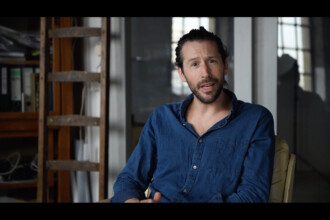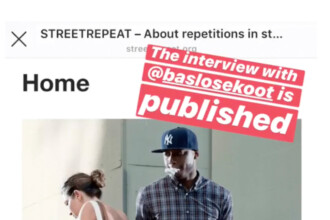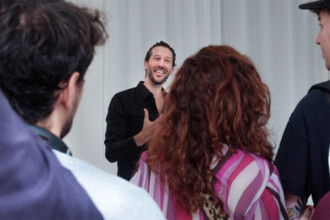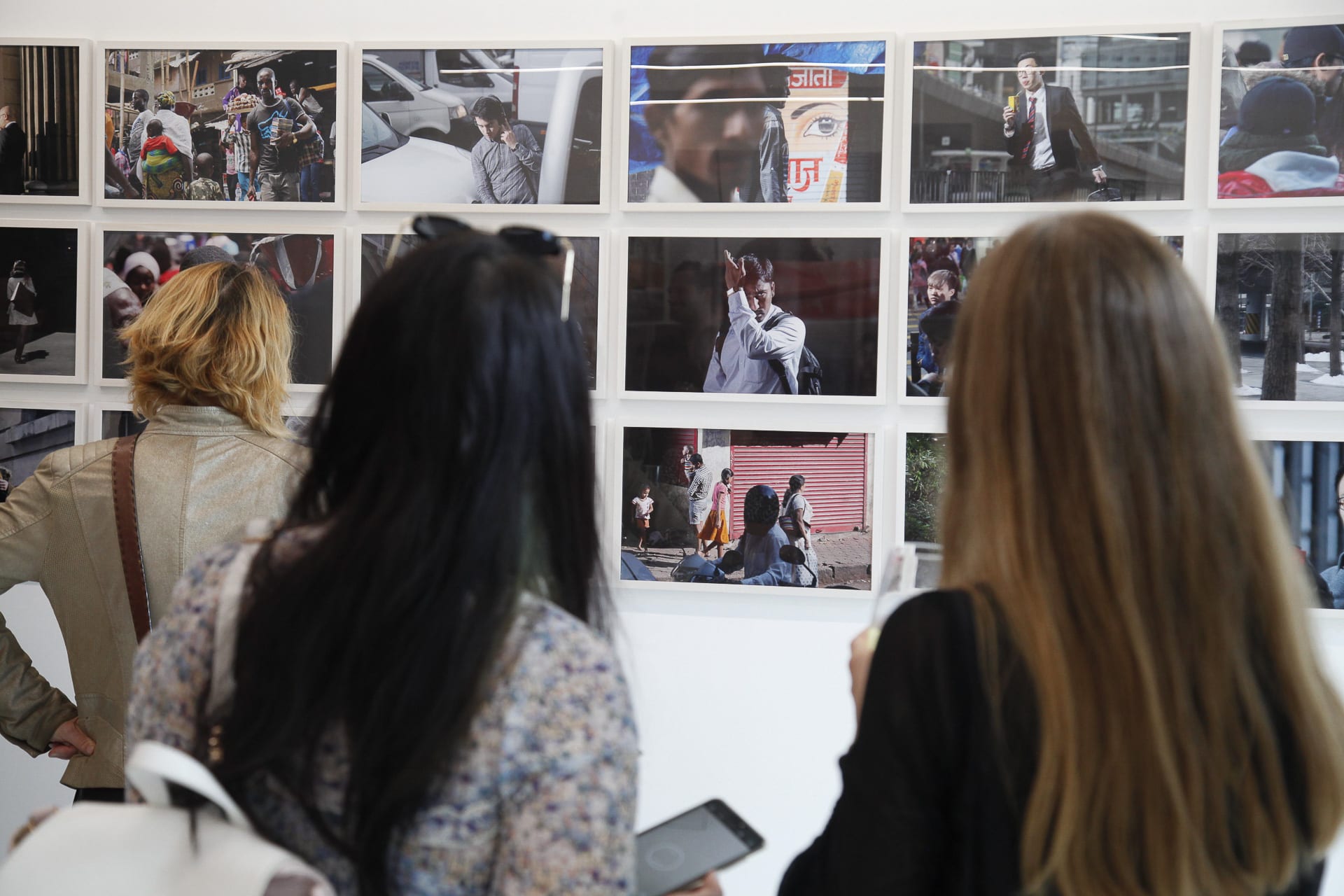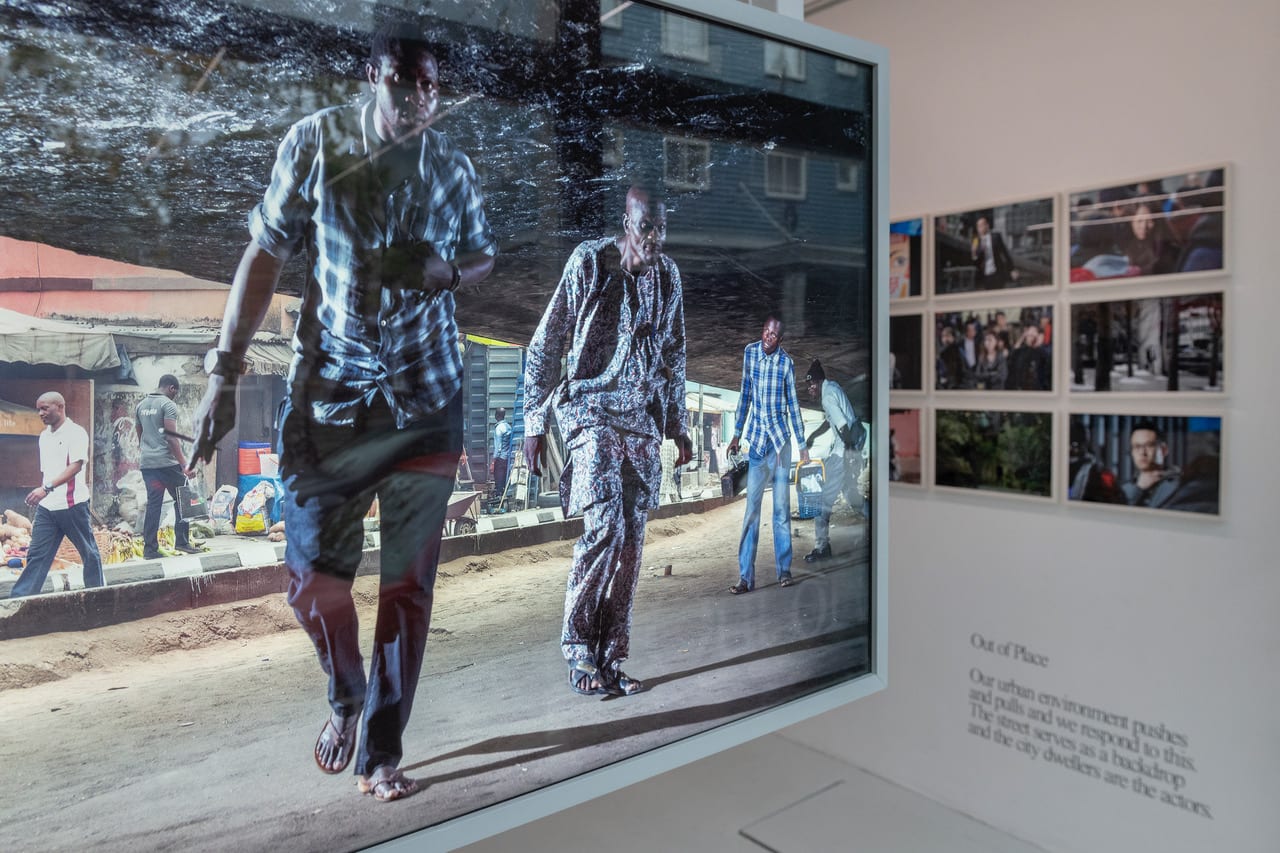It was nice do talk with Julie Hrudová from the great StreetRepeat Platform.

Hi Bas, thank you for sharing your ‘Out of Place’ project with us. Can you tell us something about it and about your approach?
In 2011, I started a visual exploration of the consequences of growing population density. I selected nine fast growing megacities around the world that hold 20 million inhabitants, or will reach this number in the next couple of years.
These cities grow with 50 new inhabitants an hour. How do people react to each other in areas of overpopulation? What does this excessive growth do with our sense of personal space in the public domain? To me street life is a continuous stream of split-second meetings. I am fascinated by the distances between people and the human scale in relation to the urban environment.
I perceive the daily movement of commuters as ballet choreography. I like to photograph in the most crowded centres of cities, where there is very little personal space and people brush-passing each other. Often I end up in places where people work, shop and travel, which is around offices, shopping areas and public transport stations. I focus on private lives in public places.
This series combines images of New York, Sao Paulo, Seoul, Mumbai, Hong Kong, London and Lagos/Nigeria, Istanbul and Mexico City. This project, including the images of 9 cities will be presented in a book that provides a sociological insight in the human condition in contemporary megacities around the world.
“I perceive the daily movement of commuters as ballet choreography.”



Your work also deals with the unwritten laws in urban areas. How do you see your own position as a photographer in that same urban space?
There are unwritten social rules which provide each individual with a certain space and freedom, as long as we leave the others alone. Within certain boundaries, it is allowed to watch and observe, to look at something in public that is actually private. We observe the stranger in public areas of the city, where we are alone in the crowd and, in company of strangers.
“As a photographer, it is all about your embodiment; the way you become part of the group. People tend to copy each other’s behaviour, which means you are able to predict people’s behaviour as in: gestures, gazes and body movement.”
And as a photographer you also capture these strangers.. How did you move around in that public space, while taking photos? Did you have the feeling you were breaking some of the ‘unwritten’ laws?
I like to capture people’s state of mind, not really their attention. That is why I never talk to people before the shutter is released. To a certain extent, I like to be invisible; hoping people are not paying attention to me. However, I am almost two meters tall and use flashlights, so not really to be overlooked. Next to that, I try to be part of the scene, adjusting my own bodily behaviour. In a sense, it is like a dance; it really surprised me how I was able to photograph people up close, while they were not noticing me at all.

I like to imagine the city as one big organism, and we dwellers move in it as city animals. For example, we like to walk in groups close to each other, and become a group; a strange sense of ‘togetherness’. When I was walking in the subway station in Mexico City, paying attention to people’s footsteps, I realised after a while, we started to walk in sync. Like a flock of starlings in the sky.
As a photographer, it is all about your embodiment; the way you become part of the group. People tend to copy each other’s behaviour, which means you are able to predict people’s behaviour as in: gestures, gazes and body movement. Paying attention to all these things you are able to pre-visualise a photograph.
“I like to imagine the city as one big organism, and we dwellers move in it as city animals. For example, we like to walk in groups close to each other, and become a group; a strange sense of ‘togetherness’.”

Which city was the most challenging one to photograph in, and why?
Without any doubts, that was Lagos / Nigeria. It is the most difficult city I have ever worked in, yet at the same time, the most interesting city I have ever worked in. I wanted this project to be a global exploration of the consequences of large scale urbanisation and population density on human behaviour. Therefore, Lagos was one of the nine cities I selected worldwide. I prepared very well before going there.
I contacted the few other Dutch photographers that had worked there, for example Chris de Bode, Kadir van Lohuizen, Martin Roemers and Lard Buurman. Some of them really discouraged me to go, mentioning I could expect lots of trouble, especially with my light setup on the streets.
Once landed in Lagos, I contacted The African Arts Foundation and they hooked me up with a fixer. We worked together every day. For example, he negotiated the prices on the streets with the local ‘area boys’, in exchange for a couple of minutes, photographing in their streets. The city is very overwhelming, but I fell in love with its energy and chaos. The only real issue is a political one, that resulted in, to put it this way, a problem of trust.



What happened?
I stayed relatively safe. Once you pay one area boy the others want to have money as well, which means you keep on paying all day long. For me this is a quite unusual way of working; in all other cities of the project i never payed anyone. In Lagos this meant i had to work under extreme time constraints, which somehow, worked out well for me.
What did the series taught you about people?
When starting this project, I was mostly interested in all the little differences of the people I photographed on the streets. However, the differences I experienced were quite obvious, until I realised, we are more the same than we are different. Due to globalisation, the centres of megacities, including its citizens, get visually amazingly homogeneous. Around the world, we see generations wear the same clothing, listening to the same music and watch the same movies. As human beings, we have more values in common than we are aware of. In the end, genetically we belong to the same group of primates, something I find a very reassuring.
“As human beings, we have more values in common than we are aware of.”



And in terms of differences… the respect for one’s personal space can vary a lot across cultures and it can affect the spacial distance between people. What were the biggest contrasts?
Yes, you can really experience big differences in cities when it comes to personal space. For example, in Mumbai the personal space is considered very small. People seem to be very comfortable with standing close to each other. Something you can experience when travelling by train.


On street level, you might see a lot of arms around shoulders, or boys holding hands, as sign of friendship. When I was photographing, a lot of people leaned on me when they came to check their picture at the back of my camera. London is, in my opinion, a very cold city. You can do whatever on the streets; hardly anybody is noticing you or concerned about who you are or what you are doing. For sure this has something to do with economics.
I photograph a lot during morning and evening traffic, when people are in transit. Also, the areas I photograph in, are business or commercial areas. People are in a hurry, stressed and they have things on their minds. They have better things to do, than standing still to talk to a stranger. You might say, there is a lot of psychological distance between them.



Did you experience some personal space difficulties yourself?
I cannot deny that I reflect the loneliness of photographing alone in the street, on the people I capture. I photograph the isolated, uncanny and even alienated people because I feel amazingly close to them. In fact, I am like them, I mean I can see myself navigating through urban space, stressed by the pressure of everyday life, like that as well.
Do you know that we all suffer a little bit from agoraphobia? It is against our human nature to cross big open spaces. Loneliness in cities is the counterintuitive mental disease number one. The suicide rate in cities is twenty times higher than on the rural country side. I never really understood how the walls of our apartments we live in can really make people isolated. There is another cosmos behind this ten centimetres, which we often never get to know.
“I photograph the isolated, uncanny and even alienated people because I feel amazingly close to them.”

With this project, I like to plea for a more open and communicating ambience on the streets we dwell every day. The encounter with the stranger might be an interesting opportunity or exciting friendship. To share experiences in real life rather than online, we can transform the street to a more human environment, where people rather look at each other than at their telephones. A small gesture to the stranger can mean a lot to him or her. I believe it is in these small urban encounters, where we are triggered by curiosity and can overcome our fear for the unknown; whether the stranger is the casual passer-by on the street or your neighbour.


As Bas Losekoot, do you look at your theme rather as a scientist who’s trying to analyse the subject, or as a person exploring his personal boundaries?
That is a very interesting question! I think I find them both equally important. Maybe Cartier-Bresson would say, photography is way to align the head, the eye and the heart. The process of research, study, thinking, are taken place usually in advance of the act of photographing.
Before the going out on the street, I set out the parameters of a concept, approach and method. After the sessions on the street, looking at the photographs, it comes to analysing, editing and storytelling. Once on the streets, I very much work intuitively. While being mindful, of my ideas, you have to let go yourself, in order to create something, you could not imagine before. It is a process of creativity, and indeed, exploring your personal boundaries.

It is important to challenge yourself, to go to places where you normally would not go to, or to experiment with different light setups, and to walk one more block, wait a little longer till the light gets better; to work until the image gets magical. It is a real inner journey, nobody on the street knows what you are busy with. It is a truly solitary process. Sometimes it can bring me into a sort of flow. In my mind, I create little stories and travel from one photograph to the next. Guided by the rhythm of the city; by colour, texture and light.
I pay a lot of attention to people’s movement, gestures, gazes and body language. I try to photograph ‘close to the skin’ and tune into people’s thoughts. Sometimes, I even forget that I am there. It is a disembodiment, or like Garry Winogrand had once stated, it is the closest you can get to non-existence.

Maybe you are right, maybe I photograph to get to know myself. Or at least, get to know more about my position towards the world ‘out there’. The camera is my invitation to explore beautiful places and to meet very interesting people. I am curious by nature. There is an intrinsic desire in me, to understand the world we live in. I really believe that good photography has the ability to provoke cultural awareness, that can lead to a better understanding of socio-political, economic and historical issues; and can even facilitate change. After working in all these cities, I hope this body of work holds up a mirror to society, and makes people think about the meaning of living in dense urban environments.

Thank you Bas!
© All the pictures in this post are copyrighted. Their reproduction, even in part, is forbidden without the explicit approval of the rightful owners.

by Julie Hrudová, founder of StreetRepeat
Website
Instagram
Facebook
